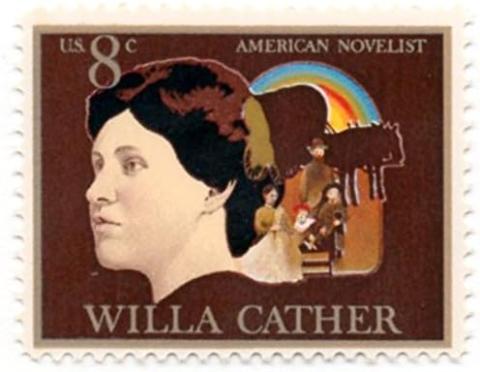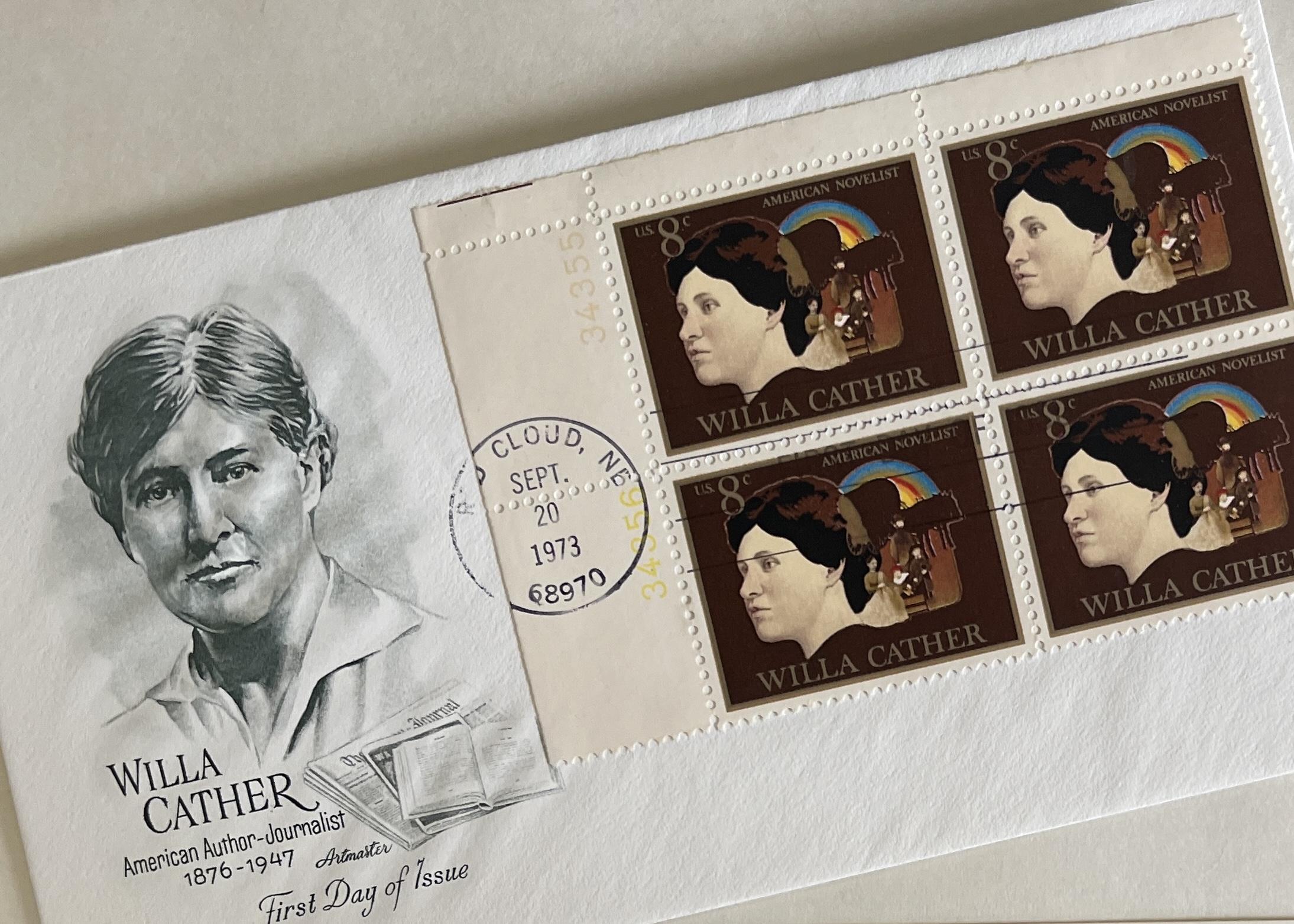
50 Years of the Centennial Willa Cather Stamp
In 1969, the Willa Cather Foundation Board of Governors pursued a series of postage stamps to commemorate the 1973 centennial of Willa Cather’s birth; the goal was to have the first stamps offered for sale in Red Cloud on December 7, 1973. What resulted four years later was a single 8 cent stamp with Cather’s likeness. Following are excerpts of that process gleaned from past newsletters. [Scroll down to read what was entered into the Congressional Record in 1969 by the two Senators from Nebraska.]
It Began With a Letter Writing Campaign
The WCPM newsletter urged “loyal Cather admirers” to write on behalf of the Commemorative Stamp to the Citizens Stamp Advisory Committee in Washington.
In the Fall of 1971, there was another appeal by the Foundation to letter writers to keep the project alive:
“Selection of stamps to be issued in 1973 is made in 1972 by the Citizens Stamp Advisory Committee. This Committee is not swayed by hundreds or even thousands of form letters that all say the same thing. Nor is the Postal Service. However, they are definitely influenced by individual letters expressing personal interest. Won’t you please help keep the project fresh and alive by using your influence?”
In the winter 1972 newsletter it was noted that plans were going forward for a statewide celebration of the 1973 centennial of Willa Cather’s birth, chaired by Robert Knoll, of the University of Nebraska, Department of English. One more appeal was issued for letters to the Citizens Stamp Advisory Committee who “soon will be selecting subjects for commemorative stamps to be issued in 1973.”
A Successful Four Year Campaign
In the summer 1973 newsletter, it was announced that an eight-cent stamp, honoring Willa Cather in the centennial year of her birth (1873-1973), would be issued September 20, 1973, at Red Cloud, Nebraska.
The Philatelic Release announcing the stamp included the following note on the work of Willa Cather:
“‘There are only two or three human stories, and they go on repeating themselves as fiercely as if they had never happened before,’ wrote Willa Cather in O Pioneers! and she practiced what she preached. Miss Cather (1873-1947) echoed in many of her novels the same theme—the spirit and courage of pioneer life, which she knew so well. Usually this was life in Nebraska, but she turned also to Canada and the southwest for Shadows on the Rock and Death Comes for the Archbishop. Upon graduation from the University of Nebraska, she worked on a Pittsburgh, Pennsylvania, newspaper, and later for a magazine in New York, deciding in 1912 to devote her time to novel writing. Her Pulitzer prize-winning novel in 1922 was followed a year later with A Lost Lady. This one made her famous. In 1931 she became the first woman to receive an honorary degree from Princeton. In 1944 she received the gold medal from the National Institute of Arts and Letters.”
50 Volunteers, 34 Extra Postal Workers, 11 Nebraska Towns, a Crowd of 500, and 600,000 Stamps
And finally, the news that the First Day of Issue of the Cather Commemorative Stamp took place September 20, 1973, in Red Cloud. A crowd of 500 gathered for the First Day Ceremonies to hear Regional Postmaster General Clarence B. Gels speak about Willa Cather. Also in the audience were relatives of Willa Cather, Memorial Board members, and postmasters from many other cities. The Fall 1973 newsletter commented:
“First Day of Issue sectors and Willa Cather admirers were out in full force for the program and for a stroll along the streets of Red Cloud, looking for souvenirs and visiting the Cather Museum and the Cather House. Red Cloud Postmaster Tom F. Wackerla employed 34 extra workers to help his regular staff handle the 600,000 First Day of Issue stamps. Ten Red Cloud organizations and almost fifty volunteers from eleven Nebraska towns helped the Memorial with First Day activities and with handling orders for the thousands of cachets, maximums, and programs that have been mailed."
The following Willa Cather Pioneer Memorial Newsletters were referenced for this article and can be downloaded in full.
- Fall 1969, Vol. 13, No. 2
- Fall 1971, Vol. 15, No. 2
- Winter 1972, Vol. 16, No. 1
- Summer 1973, Vol. 17, No. 3
Want to catch up on “all the things” at the Willa Cather Foundation? Enjoy browsing past issues HERE (this early Willa Cather Foundation Newsletter eventually became the scholarly journal, Willa Cather Review) and issues of the informational News from Cather Country HERE.
IMAGES: Willa Cather Pioneer Memorial Collection, Willa Cather Foundation Collections and Archives at the National Willa Cather Center, Red Cloud, Nebraska — Browse our digital collections HERE.

Stamp Artistry
The Cather stamp was one of four in the American Arts series, for Novelist Willa Cather, Composer George Gershwin, Painter Henry Ossawa Tanner, and Poet Robinson Jeffers. All were designed by Mark English. The stamp was printed by gravure on the Andreotti press by the Bureau of Engraving and Printing and its issuance by the United States Postal Service culminated four years of effort by the Willa Cather Pioneer Memorial and Educational Foundation, members of the Nebraska Congressional delegation, other governmental officials, and many friends. Board Member Virginia Faulkner was in charge of the program for obtaining the centennial stamp.
IMAGE: Willa Cather stamp First Day of Issue postmarked envelope, with stamps—September 20, 1973
